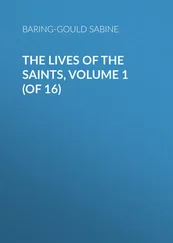Sabine Baring-Gould - The Lives of the Saints, Volume II (of 16) - February
Здесь есть возможность читать онлайн «Sabine Baring-Gould - The Lives of the Saints, Volume II (of 16) - February» — ознакомительный отрывок электронной книги совершенно бесплатно, а после прочтения отрывка купить полную версию. В некоторых случаях можно слушать аудио, скачать через торрент в формате fb2 и присутствует краткое содержание. Жанр: foreign_antique, foreign_prose, на английском языке. Описание произведения, (предисловие) а так же отзывы посетителей доступны на портале библиотеки ЛибКат.
- Название:The Lives of the Saints, Volume II (of 16): February
- Автор:
- Жанр:
- Год:неизвестен
- ISBN:нет данных
- Рейтинг книги:4 / 5. Голосов: 1
-
Избранное:Добавить в избранное
- Отзывы:
-
Ваша оценка:
- 80
- 1
- 2
- 3
- 4
- 5
The Lives of the Saints, Volume II (of 16): February: краткое содержание, описание и аннотация
Предлагаем к чтению аннотацию, описание, краткое содержание или предисловие (зависит от того, что написал сам автор книги «The Lives of the Saints, Volume II (of 16): February»). Если вы не нашли необходимую информацию о книге — напишите в комментариях, мы постараемся отыскать её.
The Lives of the Saints, Volume II (of 16): February — читать онлайн ознакомительный отрывок
Ниже представлен текст книги, разбитый по страницам. Система сохранения места последней прочитанной страницы, позволяет с удобством читать онлайн бесплатно книгу «The Lives of the Saints, Volume II (of 16): February», без необходимости каждый раз заново искать на чём Вы остановились. Поставьте закладку, и сможете в любой момент перейти на страницу, на которой закончили чтение.
Интервал:
Закладка:
Of such adventurers, the most fortunate was the Emperor Leo III., who, from the mountains of Isauria, ascended to the throne of the East. He was ignorant of sacred and profane letters; but his education, his reason, perhaps his intercourse with Jews and Arabs, had inspired the martial peasant with a hatred of images; and he held it to be the duty of a prince to impose on his subjects the dictates of his own conscience. In the reformation of religion, his first steps were moderate and cautious; he assembled a great council of senators and bishops, and enacted, with their consent, that all the images should be removed from the sanctuary and altar to a proper height in the churches, where they might be visible to the eyes, and inaccessible to the devotion of the people. But it was impossible on either side to check the rapid though adverse impulses of veneration and abhorrence: in their lofty position, the sacred images still edified their votaries, and exasperated their enemies. He was himself provoked by resistance and invective; and his own party accused him of an imperfect discharge of his duty, and urged for his imitation the example of the Jewish king, who had broken without scruple the brazen serpent of the temple. By a second edict, he proscribed the existence, as well as the use of sacred pictures; images of Christ, the Blessed Virgin, and the Saints, were demolished, or a smooth surface of plaster was spread over the walls of the edifice. The sect of the Iconoclasts was supported by the zeal and despotism of six emperors, and this topic involved the East and West in an angry conflict of one hundred and twenty years. It was the design of Leo the Isaurian to pronounce the condemnation of images as an article of faith, and by the authority of a General Council; but the convocation of such an assembly was reserved for his son Constantine Copronymus. This council was attended by three hundred and thirty-eight bishops of Europe and Anatolia, but not by those of the Western Church, African Church, or that of Palestine. It was, in fact, an assembly of those prelates who were weak enough to assist, fearing condemnation and exile if they did not submit, ambitious enough to follow the caprice of the reigning emperor, in hopes of emolument, and also of those who heartily concurred with his semi-Arianism. After a serious deliberation of six months, the prelates subscribed such a decree as the emperor desired, condemning all visible symbols of Christ, 18 18 This very term "Symbol of Christ," as applied to the Holy Eucharist, is indication of heretical views on the Presence.
except the Eucharist, as blasphemous and heretical; and denouncing veneration for images as the idolatry of Paganism. "As if," says a Catholic writer of the time, "there were not this great difference between the Christian image and the heathen idol, that the latter is the thing worshipped, whereas the former is the representation of the person adored."
The first hostilities of Leo had been directed against a lofty Christ on the vestibule, and above the gate, of the palace, placed there to exhibit to all men that the emperors had bowed before the King of kings. A ladder had been placed for the assault, but it was shaken by a crowd of women and zealots, and for their opposing the execution of the mandate, severe and savage reprisals were taken. The execution of the imperial mandates were resisted by frequent tumults in Constantinople and the provinces, which were quelled by the military, and much blood flowed.
In the cruel persecution that ensued, the monks, ever the champions of the Incarnate God, suffered most severely. Nicolas of the Studium, together with S. Theodore, the abbot, or archimandite, of the monastery were called to suffer. Nicolas was scourged with leather thongs on the back and limbs, and his arms extended, so that they became for a time paralysed. His back, which was lashed and bleeding, was tenderly bathed with warm water and healing lotions by S. Theodore, his superior, till it was healed. Both were driven into exile, and kept for three years in nakedness, and without sufficient food and drink, in a wretched prison. They were beaten again at Smyrna, and further imprisoned for twenty-two months, with their feet in the stocks. On the death of Leo, the confessors were released, and visited S. Nicephorus at Chalcedon. This took place during the absence of Constantine Copronymus, who had undertaken an expedition against the Saracens. During this absence, his kinsman, Artavasdus, assumed the purple, and everywhere the sacred images were triumphantly restored. Constantine flew for refuge to his paternal mountains; but he descended at the head of the bold Isaurians, and his final victory placed the unfortunate Catholics once more at the mercy of a brutal tyrant. This monster of crime derived his name Copronymus from having defiled his baptismal font. This incident of his infancy was accepted as an augury of his maturity, and he did not belie it. His reign was one long butchery of whatever was most noble, or holy, or innocent, in his empire. In person the emperor assisted at the execution of his victims, surveyed their agonies, listened to their groans, and indulged, without satiating, his appetite for blood: a plate of noses was accepted as a grateful offering, and his domestics were often scourged or mutilated by his royal hand. His long reign was distracted with clamour, sedition, conspiracy, mutual hatred, and sanguinary revenge. The hatred borne by this ruffian against monks and images was implacable. Images were torn down and defaced with wanton malice throughout the empire by an officer called the Dragon, sent round for that purpose; all religious communities were dissolved, their buildings were converted into magazines or barracks; the lands, moveables, and cattle, were confiscated, and the monks were mutilated in eyes and ears and limbs, with refined cruelty.
Under this emperor, Theophilus (829), Nicolas and Theodore again suffered persecution. Theodore, and the abbot Theophanes, kinsman of Nicolas, were mutilated by certain verses being cut upon their brows. During the persecution, S. Nicolas remained concealed; on the accession of the indifferent emperor, Michael III., (842), he emerged from his hiding place, and was elected archimandite of the Studium, the abbot Theodore being dead. After exercising the government for three years, he resigned it to Sophronius, and retired to Firmopolis, that he might pass the remainder of his days in peace; but it was not so to be; after four years he was recalled to the abbacy of the Studium, on the death of Sophronius, and was at once involved in conflict. For the patriarch Ignatius, having rebuked the Cæsar Bardas for incest, and then excommunicated him, the emperor Michael III., his nephew, was persuaded to exile Ignatius, and to intrude Photius into the Patriarchal see. The abbot Nicolas refused to communicate with the intruder, and was consequently driven from his monastery, and a monk, Achillas, was appointed in his room. Nicolas was pursued from one retreat to another by the hostility of the intruded patriarch, and after many wanderings, rested in the Crimea. Upon the death of Bardas and Michael, Bardas having been murdered by his nephew Michael, and Michael by his successor, Basil I., (867), the patriarch Ignatius was recalled, and the patriarch persuaded Nicolas to return to his government of the Studium, where he died the following year.
[Roman Martyrology; this being the day of his consecration to the Archbishopric of Bremen and Hamburg. But in some German Martyrologies, on June 11th, the day of his death. Authority: – his life written by a coeval author or authors].
This saint was born at Thourout, in Flanders, where was a monastic cell, that had been given by King Louis the Pious to S. Anskar. As Anskar was at Thourout one day, he noticed some boys going to church, and amongst them was one who, by his gravity, pleased him; and when the boy entered the church, he crossed himself, and behaved with so great reverence, that the archbishop went to him, and asked his name. He told him that he was called Rembert. Then S. Anskar took him and placed him in the little monastery, and bade that he should be well instructed. In after years, the apostle of Sweden called Rembert to assist him in his mission; and he loved his young friend greatly, and prayed to God for three days incessantly that He would grant to Rembert to accomplish the work that he, Anskar, had begun, and to make them companions together in the Heavenly Zion. After Anskar died, in 865, S. Rembert was unanimously chosen Archbishop of Hamburg and Bremen, and he superintended all the churches of Sweden, Denmark, and Lower Germany. He also began a mission to the Wends and Sclavonic race of Mecklenburg and Brandenburg, which was attended with considerable success. He sold the sacred ornaments of the Church to redeem captives from the Northmen. On one occasion he saw a party of these marauders pass, dragging after them a poor girl, who raised her shackled hands towards the bishop, and began to chant one of David's psalms. Then S. Rembert leaped off his horse, and ran to the chief, and offered him the horse if he would release the captive Christian maiden. And this he did, well pleased to obtain so valuable a horse. S. Rembert died on June 11th, in the year 888.
Читать дальшеИнтервал:
Закладка:
Похожие книги на «The Lives of the Saints, Volume II (of 16): February»
Представляем Вашему вниманию похожие книги на «The Lives of the Saints, Volume II (of 16): February» списком для выбора. Мы отобрали схожую по названию и смыслу литературу в надежде предоставить читателям больше вариантов отыскать новые, интересные, ещё непрочитанные произведения.
Обсуждение, отзывы о книге «The Lives of the Saints, Volume II (of 16): February» и просто собственные мнения читателей. Оставьте ваши комментарии, напишите, что Вы думаете о произведении, его смысле или главных героях. Укажите что конкретно понравилось, а что нет, и почему Вы так считаете.












